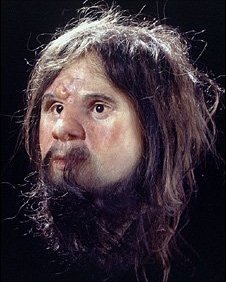Filed under: Europe, History, United Kingdom | Tags: circa 7000 B.C., The Canyon Cave Man, Today's Direct Descendant

…..The Canyon Cave Man. Not long after the last Ice Age, not far from the western sea, a young man was buried in a cave set high in the walls of a limestone canyon. Beside him lay a strange long object made of antler bone, variously described as some sort of secptre or perhaps a spear-straightener. The shallow grave on the cave floor was surrounded by thousands of flints — the non-perishable parts of Stone Age spears, knives, scrapers and burins. These in turn were accompanied by heaps of bones from the birds and animals which had supplied the cave dweller’s diet; hence wild horse, reindeer, and red deer; blue hare, brown bear, Arctic fox, and willow grouse; pig, ptarmigan, peregrine falcon; and one solitary and much older, mammoth bone. The cave and its contents remained undisturbed until rediscovered in modern times.
…..Caves were one of the favorite places of refuge for prehistoric people. They provide shelter in all seasons, an even temperature, and protection from wild animals. Unlike a neighboring cavern, which had once served as a den for hyenas and which had been used by humanoids in far remoter ages, the ‘Canyon Cave’ had not been inhabited before the last ice had melted. Its cool, but never freezing air was ideal for the growth of of stalactites and, in our own times, for the fermentation of cheese. When the Anglo-Saxons arrived some seven or eight thousand years after the cave burial, they founded the nearby village, and called it Ceodor—their word for a canyon or ravine. When the Normans came five hundred years after the Anglo-Saxons, they called the ravine a gorge — their word for a throat and for a narrow valley. …
…..For ninety years after its discovery in 1903 in Gough’s Cave, Cheddar Gorge, the skeleton of ‘Cheddar man’ was kept in London’s Natural History Museum. But in 1996 it was the subject of an extraordinary experiment. It was sent to the Institute of Molecular Medicine in Oxford for DNA testing, and samples of its mitochondrial DNA were compared with a score of similar samples taken from volunteers among the villagers in the present-day Cheddar district. To the astonishment of the scientists, as The Times reported, ‘a close match was found between Cheddar Man and Mr. [Adrian] Targett’, a forty-two-year-old history teacher at the Kings of Wessex Community School in Cheddar Village. The experiment had proved beyond reasonable doubt that a man living in late twentieth century Britain was a direct descendant through the maternal line, of a person living in the same locality in the Middle Stone Age.
This account comes from Norman Davies The Isles: a History. Mr. Davies goes on to explain that the Targett case would indicate that a substantial proportion of people in modern Britain form part of local kinship groups which have had a continuous existence for three or four hundred generations.
Then came the Celts, Romans, Saxons, Vikings, Normans, and Angevins of historic times. The head, above, is a forensic reconstruction from the skull of Cheddar Man, c. 7,000 BC.
I have long found this account absolutely fascinating, and thought you might too. This is what thinking about Richard III got me into.
Filed under: History, Literature, United Kingdom | Tags: Battle of Boswerth Field, Last Plantagenet King, Richare III King of England
What a fascinating story. DNA testing has confirmed that the skeleton dug up below a parking lot behind the council buildings in Leicester, is that of Richard III, the last Plantagenet King of England. Richard III was one of Shakespeare’s great villains. The bones were found amid the foundations of a Franciscan friary, the very place where history said Richard’s body was taken after the Battle of Bosworth Field in 1485.

Modern science could compare mitochondrial DNA taken from the 500-year-old skeleton with DNA from a living descendant of Richard’s sister. Richard became king in 1483, taking power from his nephew, the 12-year-old Edward V. Richard was said to have imprisoned his two nephews in the Tower of London, and within months of Richard’s taking the throne, the two nephews disappeared. Tudor supporters claim that he had his nephews murdered.

This portrait from the National Portrait Gallery dates from the 16th century, so it may not be representative, or may be derived from lost sketches.
Plantagenet supporters say a closer look at Richard’s reign shows him as one of the most progressive rules of his time who promoted trade and books. Another battle will occur over where Richard’s remains are to be buried. Leicester wants to keep him as a tourist attraction, others believe he should be interred. Richard III enthusiasts had called for the skeleton to be buried in York and others in Westminster Abbey or Windsor Castle, where other monarchs are interred.

What is most fascinating to me is the extent to which the discovery of the skeleton confirms the history as it is known. The body’s hands appeared to have been tied, and the skeleton shows that he probably died from blows to the head, which is consistent with contemporary accounts. The skeleton shows severe spinal abnormality from scoliosis which shows that Shakespeare’s depiction of Richard as a hunchback was accurate. The discovery will renew interest in the last Plantagenet King of England, and perhaps renew interest in history as well.
Filed under: Capitalism, Democrat Corruption, Economy, Energy, Progressivism, Statism | Tags: 7.9 % Unemployment, Obama's Record, The New Normal
I want to quote AEI’s James Pethokoukis here:
Nations probably never choose decline, at least not consciously. More likely they become victims of a creeping normalcy. Things once objectionable can become passively acceptable if they happen slowly, incrementally: the boiling-frog syndrome. Decline just sort of happens, year by year, decade by decade, one “meh” economic report at a time.
The important phrase is “creeping normalcy,” accepting as normal and natural a situation that is anything but. Obama has had four years, going on five, of over 7% unemployment. That is neither normal nor acceptable. When the Labor Department reported a decline in GDP and a rise in the unemployment rate to 7.9%, we should be angry about it. It doesn’t need to be this way. We have a history of successful recovery from downturns, and we know how to do it.
The economy added 157,000 net new jobs. Obama apparently sees this as progress, but at that rate of job creation, all else being equal, the economy would not return to 4.4% —the George W. Bush administration’s low point — for another eight years.
A president actually concerned about growth would have followed some of the recommendations of his Jobs and Competitiveness Council. He would have approved a pipeline. He would have expanded domestic oil and gas drilling, and fixed the corporate tax code. He would have put a brake on new regulation. Of all the things that may be wrong with our economy, a lack of enough regulation is not one of them.
This is not the new normal. This is the result of deliberate choices by a president who values payback for his supporters more highly than creating jobs. When something goes on too long without real signs of progress, it’s easy to slide into thinking that this is just the way it is, and it will always be like this, Do not accept sluggish growth and high unemployment as normal. This is not normal, it is defeatism. Fight back.


























